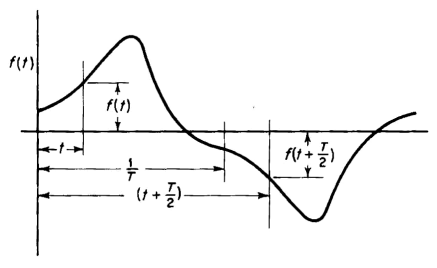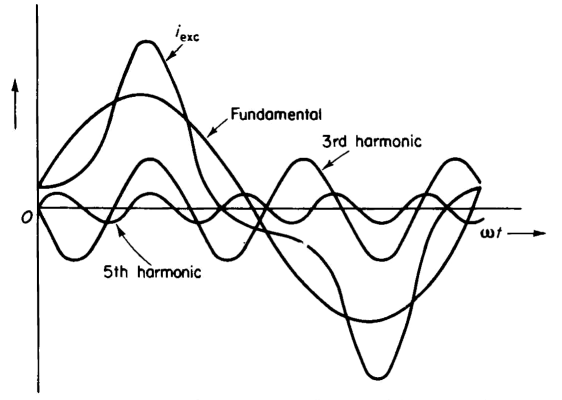| Capacitors, Magnetic Circuits, and Transformers is a free introductory textbook on the physics of capacitors, coils, and transformers. See the editorial for more information.... |

|

Home  Excitation Characteristics of Iron-Core Reactors Excitation Characteristics of Iron-Core Reactors  Harmonics Harmonics |
|||||||||||||||||||||||||||||
| See also: Third Harmonics in 3-Phase Transformer Operation | |||||||||||||||||||||||||||||






|
|||||||||||||||||||||||||||||
Harmonics
Under steady conditions of constant voltage and constant frequency, the current in a reactor, or the exciting current (the no-load current in a transformer), is a periodic function of time. A periodic function can be represented by a Fourier series as follows
The constant a0 corresponds to a d-c component. Under steady-state conditions, if the applied voltage does not contain a d-c component, the constant a0 is equal to zero. With a-c excitation only, the exciting current has symmetrical wave form, i.e., the negative half cycle has the same shape as the positive half cycle. Figure 5-5 shows a symmetrical wave, i.e., one in which f[t + (T/2)] = -f(t). A symmetrical wave contains odd harmonics only because the presence of even harmonics leads to dissymmetry. Then, for a constant frequency, the angular velocity ω must be constant, and the wave is symmetrical when
In Eq. 5-21, T is the period or the time for the wave to undergo a complete cycle. Hence, ωT = 2π radians, and Eq. 5-21 can be reduced to
If the nth harmonic in the cosine series is to satisfy the conditions for symmetry
but
then, from Eqs. 5-23 and 5-24, symmetry requires that
and
Equation 5-24 can be satisfied only if n is odd; as for even values of n, cos nπ is 1. Similarly
only if n is odd. It follows, therefore, that only odd harmonics are present in a periodic function that is symmetrical, as is the case for an iron-core reactor or the exciting current in an iron-core transformer when the flux wave is symmetrical. Such a current can therefore be represented by omitting a0 and all the even harmonics in Eq. 5-20 as follows
Equation 5-27 can also be put into the following form
where
Hence, if I1 is the effective value of the fundamental component of current, and I3, I5, etc. are the effective values of the harmonic components, the exciting current can be expressed by
A sinusoidal flux variation with respect to time produces a distorted current in an iron-core reactor or in iron-core transformers, which can be divided into a fundamental component and into odd harmonic components. The third harmonic is the predominating harmonic.
The amplitudes of the harmonics generally decrease as the order of the harmonics increases, harmonics of higher orders than the 9th usually having negligible amplitudes. Figure 5-6 shows a current wave with its fundamental, 3rd harmonic, and 5th harmonic components.
|
|||||||||||||||||||||||||||||
Home  Excitation Characteristics of Iron-Core Reactors Excitation Characteristics of Iron-Core Reactors  Harmonics Harmonics |
|||||||||||||||||||||||||||||
Last Update: 2011-01-14
















